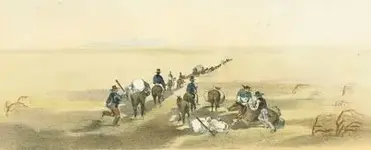GL
Bronze Member
- #1
Thread Owner
This may not be gold dubloons or a box of diamonds...but how cool is THIS?
For four centuries, they were the ultimate pack rats. Now a Maryland family's massive collection of letters, maps and printed bills has surfaced in the attic of a former plantation, providing a firsthand account of life from the 1660s through World War II.
"Historians are used to dealing with political records and military documents," said Adam Goodheart, a history professor at nearby Washington College. "But what they aren't used to is political letters and military documents kept right alongside bills for laundry or directions for building a washing machine."
Goodheart is working with state archivists and a crew of four student interns to collect the documents, which were found stuffed into boxes, barrels and peach baskets.
"Look at this: 'Negro woman, Sarah, about 27 years old, $25,'" Goodheart says, reading from a 19th century inventory. "It was as though this family never threw away a scrap of paper."
The documents include maps, letters, financial records, political posters, even a lock of hair from a letter dated Valentine's Day, 1801. There's a love poem from the 1830s (in which a young man graphically tells his sweetheart what he'd do if he sneaked into her room on a winter's night), along with war accounts and bills of sale from slaves and crops.
The papers come from several generations of the Emory family, prominent tobacco and wheat farmers who settled here on a land grant from Lord Baltimore in the 1660s.
The former Poplar Grove plantation is still in family hands, though the mansion now is used only as a hunting lodge. The documents were moldering in an attic until students touring the house started sorting through them this spring.
"I don't believe any of us knew these papers were there," said Mary Wood, an Emory cousin whose son inherited the plantation in 1998. "We didn't go there all that often, and when you do, you don't go up in people's attics and look around."
Washington College has had access to the plantation for years, but Goodheart said he assumed the papers in the attic weren't old or important.
They aren't in any particular order, and some are mouse-eaten tatters that look like something out of "The Da Vinci Code."
"You really get a sense of the range of America through these papers," said Edward Papenfuse, director of the Maryland State Archives, which will eventually house them.
Perhaps most strikingly, letters tell of a family's torn allegiances during the Civil War. The Emorys lived on Maryland's Eastern Shore, across Chesapeake Bay from Baltimore, where the plantation economy of the South ended and the abolitionist industrial North began.
It was a conflict the Emorys catalogued, anti-slavery petitions stacked alongside records of slaves sent to Natchez, Miss., and a packet of letters, still tied in silk ribbon, titled, "Correspondence with W.H. Emory and wife in regard to his resignation from U.S. Army, 1861."
The Emorys owned slaves, but some signed an 1832 petition to the Maryland legislature calling for the gradual eradication of slavery.
One family member, William H. Emory, was a colonel in the U.S. Army when the Civil War began. He wrote out a resignation of his post, then changed his mind and fought for the Union.
Two sons also fought in the Civil War — one for the Union, one for the Confederacy. Bundles of letters from all family members detail their divided feelings. The family kept not just personal letters, but political posters about the conflict.
"These are things that usually do not survive," Papenfuse said, pointing to a broadside blasting then-President Martin Van Buren for favoring voting rights for "every free negro." "After the heat of a campaign, this printed matter was thrown out or put to other uses, including the outhouse."
Not so at the Emory house, where even small scraps of paper were kept alongside military uniforms and other family heirlooms.
The collection also includes notes on an aspect of slavery historians know little about: the practice of renting slave labor to neighbors and plantations farther south.
"Scholars have not paid a great deal of attention to it, but this is something that helps recreate and draw back together the lives of these people who were considered chattel," Papenfuse said.
Relatives are also curious to know what historians find.
"I can't believe they didn't throw this stuff out," Wood said with a chuckle. "I mean, it's kind of weird. It's fascinating, though. I can't believe that something might come out of it."





